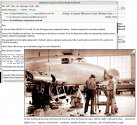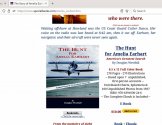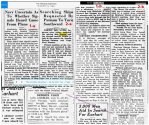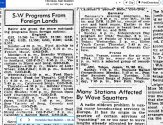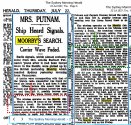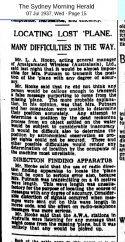Yes, it is good information, especially for amateurs like myself. The TIGHAR information and reports always sound well researched and optimistic, but it’s very helpful to hear some skilled rebuttal.
I can’t fathom making such a long trip over the Pacific Ocean back in those days, especially with such little assistance for navigation. I assume there was also little traffic in the air or on the ocean at that time.
Ms
@Betty P, aviators in those days were truly larger than life, IMO. Flying long distances with only dead reckoning and celestial navigation, over water--"Homeric" comes to mind. (The Greek one, not the cartoon one who eats doughnuts.) Accurate celestial fixes airborne? I've always been amazed at the idea of getting star sights accurately with a sextant--Richard might be able to tell us how hard it is with a bubble octant aboard a moving airplane.

And THANKS, Richard! Fascinating! And 28VDC explains why all the aircraft dynamotors I looked were 28v, I thought it might be headroom for a 24v system (easy to double existing 6/12v systems). Too much for my brain but if the dynamotors and batteries had been undamaged, IMO the transmitter could have been workable for several hours. I still don't think it HAPPENED ;-) but it's possible.

Portable tube radios used 90-volt "B batteries" (that RA-1B you posted--notice it had A and B voltage inputs on the faceplate?) but something like an aircraft/ship radio couldn't, and would need a dynamotor (in those primitive days) to supply the high-voltage "B" bus for the tubes, anywhere from 300 to 600vdc depending on circumstances. Great story about the automatic emergency beacon!

Two other housekeeping notes: it's always good to have an excuse to watch "Casablanca" again.

And Betty, TIGHAR's reports always sound well-done to me, superficially, but I saw a national parks person explain once on TV that TIGHAR brings in a lot of money taking "patrons" or whatever on expeditions. If they admitted that there is *NO* serious evidence that KHAQQ wound up anywhere but Howland, they'd cut their income stream, I suspect. When they cite 'evidence' I know something about (HF radio communications) it often strikes me as bogus.
Or even if it is technically correct, it may still be insanely implausible, IMO. Take
one example: I looked up the HF propagation numbers for 1937 (solar 11-year cycle affects shortwave radio propagation) and it was very good then. Meaning a harmonic just possibly *MIGHT* have been audlble in that girl's home in New Jersey, the 'disturbed girl' who reported hearing AE chatting away for hours into a microphone--might have been audible if it had been Morse code. AM-modulated voice would NOT have been clearly audible, no way, IMO, But the Electra could not transmit except on 500, 3105, and 6210kHz, so it could
only have been a harmonic that was heard, if it had been heard. Which it couldn't have been IMO.
OK,
so if that girl heard AE for real, on a harmonic that was 40dB (or whatever) down from a main signal--why didn't ANYBODY hear the main signal? There were literally hundreds of ships, planes, ground stations, and home listeners all over that area, and THOUSANDS in the general Aus/NZ/Pacific area, and many or most of them spent time LISTENING after AE was reported down. So how is it that one disturbed girl heard that nonsense about suitcases in a closet, and NOBODY ELSE? If the girl had been able to hear it on a harmonic from a nonresonant antenna system, so far away, hundreds of other people WOULD have heard it on the primary frequency--it's just that simple. IMHO.
One actual professional radio installation (professional, as distinct from 'amateur radio' stations like mine) reported hearing such a signal, not THAT one but another supposed AE one. Wailupe, I think? But the guy reported that while it was hard to tell what AE was saying, he was certain it was the same voice he had heard the previous night during the Howland flight. You couldn't tell what she was saying, Mr Wailupe radio operator, but you could hear it well enough to be certain it was the same voice? And nobody else heard it? I do not call that 'credible,' not for all the coconut crabs on Nikumaroro. People WANT to believe these things.
It's like the JFK book that claims that a Secret Service agent shot JFK accidentallly, from the moving limo, and the accident was covered up with a story about an assassination. It might be just barely within the bounds of possibility, like maybe a one-in-ten-million chance, IMO, but it's simply nonsense to believe it happened when 9.999 million other explanations are more likely. IMO.
Poo. Sorry; once again I have let my fingers get carried away. "Too long, didn't read"--sorry. :-/ --ken






 modelaircraftinthecinema.blogspot.com
modelaircraftinthecinema.blogspot.com









